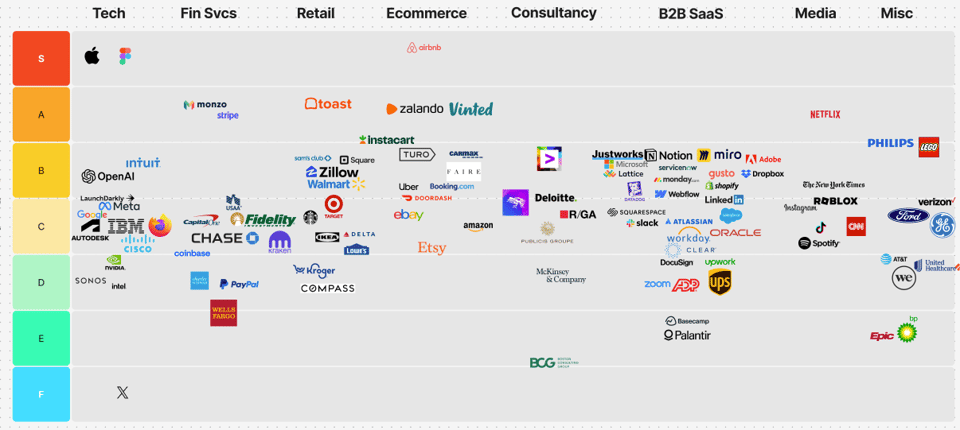[TMA] First person design leadership stories; rankings redux

From the desk of Peter Merholz—
Last Friday, Hang Xu and I continued our discussion ranking design organizations. My write up for our first session shocked me by becoming my most-viewed LinkedIn post, ever. Clearly, there’s hunger for understanding organizational perception, health, and maturity. (Which makes my court-jester approach feel a little unworthy of the insights people crave. But that’s a different story…)
For the second round, I categorized the organizations by industry, made a couple adjustments based on feedback I’d received after the first one, and then placed a few more companies, arriving at what you see below.

There’s much that could be unpacked, but I’ll just share a couple of talking points that emerged…
Why aren’t financial services ranked higher?
A possible surprise is the “C” rank for so many financial services firms, particularly those with large, senior UX/Design teams. This is not meant to be a ding on those design orgs directly—the talent, capability, potential, and savvy of the people in these orgs is industry-leading. I rank them here because, for all their capability, these orgs don’t meaningfully affect the core business of the companies that they’re part of. Strategic decisions about where to apply resources (people, money), launching new initiatives, etc., are not driven, or even informed, by design. The primary value these UX/design organizations deliver is improved utility and usability. While these are important considerations when delivering services affecting customers’ finances, they’re not strategic. It’s not UX/Design’s fault—it’s just the reality of these kinds of companies.
In the US, UX-driven upstarts (remember Simple?) struggle because the nature of regulation for American banks means they don’t really succeed (or fail) due to superlative user experience. This is in contrast to the UK, a more open regulatory environment, where Monzo (rank: A) has captured significant market share because it offered a superior experience, and research and design have been integral in that success.
If I’m wrong about US financial services, if there are stories of how UX/Design proved essential for meaningful competitive success, I’d love to hear it.
Why are B2B SaaS firms ranked so high?
Within B2B SaaS, there’s a clutch of companies in the B tier. Part of the reason I wanted to do these rankings in the first place was to shine a positive light on organizations that are typically neglected in discussions about design. While not perceived as “sexy,” these B2B SaaS companies have very senior design leadership (one or two rungs from the CEO), sizable orgs, and are influencing the strategic direction of the product and service offerings. I find B2B SaaS refreshing because the value exchange is direct and above-board—customers pay for the value they receive. Recognizing this, many of these companies have staffed strong, effective design organizations to help them better compete.
First person design leadership stories
What does a “middle manager” design leader actually do? Uday Gajendar’s breakdown of his experience as a design director, across tactical, strategic, operational, and relational activities, is the kind of ‘behind-the-scenes’ look we need more of.
A few days later, Elizabeth Eagle-Simbeye wrote about The New Language of Design Leadership, summed up with this thesis:
…design leadership is more than aesthetics; it’s about orchestrating a shared language where empathy guides us to truly understand the user, data grounds our decisions in reality, and a dash of bold provocation disrupts stagnant thinking.
Like Uday, she discusses the need to find balance between the competing forces in her work:
…design leadership has become a balancing act — finding harmony between the aspirational and the practical, between the intuitive and the analytical.
Design Leadership Summit
Next week, I’m in Toronto for the Design Leadership Summit. In the next newsletter, I’ll share whatever insights I’ve gleaned from connecting with this community.
—peter
Add a comment: